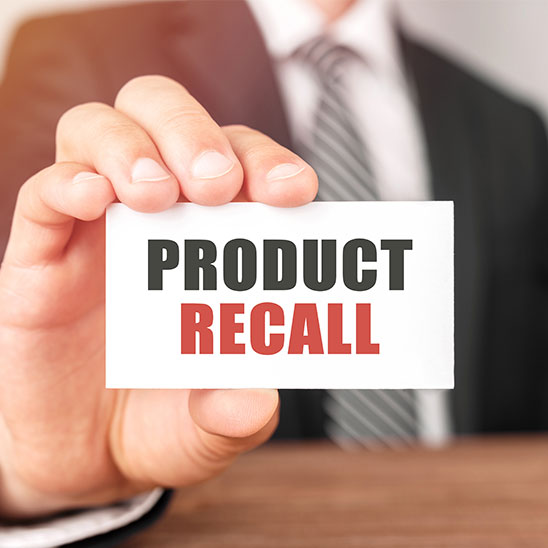Products recalled by the FDA pose safety risks for consumers. Unsafe products include prescription medications, over-the-counter drugs, vaccines, medical devices, food and beverages, cosmetics, and children’s furniture, clothing, and toys.
FDA Safety Protects Consumers
The U.S. Food and Drug Administration (FDA) is a branch of the federal government that regulates and oversees consumer product safety. As part of the U.S. Department of Health and Human Services, the FDA protects public health by making sure that products are safe and effective for American consumers.
The Food and Drugs Act was established in 1906 to protect public health and safety. It authorized the FDA to demand evidence of safety for new drugs, issue safety standards for foods and products, and conduct factory inspections to ensure regulations were being followed.
In 1976, the Medical Device Amendments were enacted after faulty medical devices were linked to over 10,000 injuries and 731 deaths. New laws were established to regulate safeguards for all new medical devices manufactured after 1976.
Today, the FDA regulates $1 trillion worth of products each year. The FDA ensures the safety and effectiveness of various products, including:
- Drugs and medications
- Biological products including blood, vaccines, and tissues for transplantation
- Medical devices, including those that emit radiation
- Food and beverages excluding meat, poultry, and some egg products
- Cosmetics
- Animal drugs and food products
Product Recalls
When the FDA gets information that a certain product under its jurisdiction is potentially dangerous to consumers, the agency takes action to recall those products. Dangerous products may be contaminated, defective, or pose major health and injury risks to the public. Personal injury lawyers often see serious injuries, disabilities, and life-long health problems caused by many defective over-the-counter products.
In most cases, the FDA works directly with product manufacturers to get them to issue voluntary recalls of dangerous products that pose harm. The FDA rarely requests recalls on their own unless there are significant injury risks to the public. Product recalls are classified into three different categories:
Class I Recalls
A Class I recall is considered the most serious and urgent type of FDA recall because it poses the most serious risk of injury and/or death to consumers. Class I recalls usually pertain to defective products or medications with high risks of injury and death.
Class I recalls often include over-the-counter medications that are contaminated from a toxin. Other examples include confirmed cases of food with Clostridium botulinum toxins; ready-to-eat foods containing Listeria monocytogenes; ready-to-eat foods containing Salmonella; foods that contain ingredients that are undeclared allergens likely to cause allergic reactions in sensitive people; and foods that do not declare ingredients.
Class II Recalls
Class II recalls usually indicate short-term health risks from a product without serious complications or dangers. Class II indicates only a slight chance of serious injury. Examples of Class II recalls include botulinum potential and Norovirus contamination in seafood. Other examples of Class II recalls include:
- Mislabeled medications
- Missing safety leaflets or inserts in medications
- Drugs with microbial contamination
- Products that are non-sterile
- Tainted food and beverage products
- Unsafe medical devices
Class III Recalls
Class III recalls represent the lowest risks to health and safety. Class III recalls are usually non-safety related. In these cases, products meet acceptable FDA standards for efficacy and consumer safety however, they may present future hazards if not rectified.
Class III recalls may include medicines with faulty packaging or closures; medicines containing microbial spoilage or debris; and medical devices with mislabelled expiration dates or improper packaging.
According to the U.S. Consumer Product Safety Commission (CPSC), when injuries or deaths caused by a consumer product are reported, products are recalled and pulled from store shelves. However, many dangerous products are already in the hands of consumers by the time a recall occurs.
Thousands of children’s products are recalled every year when dangerous designs and manufacturing defects cause injuries and fatalities. Indiana personal injury lawyers witness many injuries and deaths to children due to defective cribs, high chairs, strollers, car seats, playpens, toys, clothing, foods, and medicines. By the time a recall occurs, many unsuspecting parents are already using the products. The extensive list of infant and children product recalls found on the U.S. Consumer Product Safety Commission website includes a wide variety of hazardous products, but many parents never check the list or do not know that it is available to the public.
When injuries and/or fatalities are caused by recalled products, injury victims have the right to file a lawsuit with a personal injury lawyer to recover damages. If injury results in death, a personal injury lawyer can file a wrongful death lawsuit on behalf of the victim’s family. In cases where a significant amount of injuries occur, a class action lawsuit may be filed on behalf of all injured parties.

